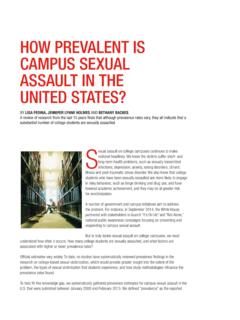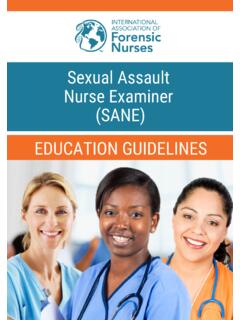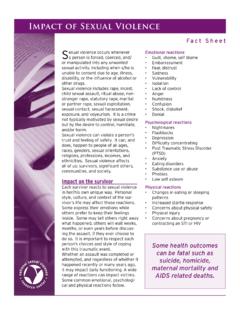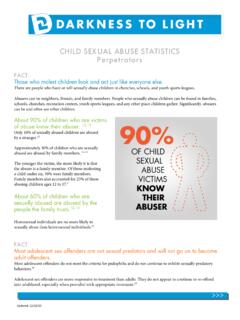Transcription of A National Protocol for Sexual Assault Medical Forensic ...
1 A National Protocol for Sexual Assault Medical Forensic Examinations Adults/Adolescents Second Edition Department of Justice Office on Violence Against Women April 2013 NCJ 228119 i Acknowledgments Many individuals contributed their skills and expertise to the development of this Protocol . Special appreciation goes to Kristin Littel, who served as the primary writer and researcher for the Protocol . We would also like to thank the Office for victims of Crime for initiating this project and for providing feedback and guidance throughout the drafting process. We are grateful to all of the women and men who gave their time and energy to attend the focus groups, participate in the conference calls, and review numerous drafts of the Protocol ; their efforts greatly enhanced the final product. We are particularly grateful for the assistance of Gail Burns Smith who, in addition to participating in focus groups and conference calls and submitting insightful comments on drafts, also was responsible for suggesting and organizing conference calls with victims to ensure the victim-centeredness of the Protocol .
2 Ii iii Foreword Sexual violence continues to plague our Nation and destroy lives. All members of society are vulnerable to this crime, regardless of race, age, gender, ability, or social standing. When Sexual Assault does occur, victims deserve competent and compassionate care. This second edition of the National Protocol for Sexual Assault Medical Forensic Examinations provides detailed guidelines for criminal justice and health care practitioners in responding to the immediate needs of Sexual Assault victims . We know that effective collection of evidence is of paramount importance to successfully prosecuting sex offenders. Just as critical is performing Sexual Assault Forensic exams in a sensitive, dignified, and victim-centered manner. For individuals who experience this horrendous crime, having a positive experience with the criminal justice and health care systems can contribute greatly to their overall healing. As we have learned in the years since the implementation of the 1994 Violence Against Women Act, coordinated community efforts are the best way to stop violence against women, hold offenders accountable for their crimes, and promote victim healing and recovery.
3 That is why this Protocol was designed as a guide for practitioners who respond to victims of Sexual Assault , including health care professionals, law enforcement officers, prosecutors, interpreters, advocates, and others. Combining cutting edge response techniques with collaboration among service providers will greatly enhance our ability to treat and support victims as well as identify and prosecute the sex offenders. We hope that this Protocol lays the foundation for these efforts. Since this Protocol was initially released in 2004, the state of the art for Forensic Medical examinations has improved. This revised edition of the Protocol has the same emphasis and values as the original but has been updated to reflect current technology and practice. It has also been updated to include additional information reflecting changes from the Violence Against Women Act of 2005. It also includes minor technical changes identified in May, 2013. iv v Contents Goals.
4 1 Recommendations at a Glance .. 4 Introduction .. 12 Background .. 12 About this document .. 13 Use of terms .. 14 Section A. Overarching Issues .. 21 1. Coordinated Team Approach Understanding the purpose of the exam .. 23 Key responders and their roles .. 23 Quality assurance measures .. 26 2. Victim-Centered Care .. 29 Patient priority as an emergency case .. 29 Patient privacy .. 29 Exam adapted to patients needs and circumstances .. 30 Issues commonly faced by patients from specific populations .. 31 Importance of victim services within the exam process .. 39 Presence of personal support persons in the exam room .. 41 Requests for a responder of a specific gender .. 41 Explanation of procedures during the exam process .. 41 Respect for patients priorities .. 41 Integration of Medical and evidentiary collection procedures .. 41 Patient safety during the exam process .. 42 Information patients can review at their convenience .. 42 Physical comfort needs of patients.
5 42 3. Informed Consent .. 43 Seeking informed consent as appropriate .. 43 Obtaining consent from specific populations .. 44 4. Confidentiality .. 47 Scope and limitations of confidentiality .. 47 Building understanding of confidentiality issues .. 47 Impact of federal privacy laws .. 48 Resolving intrajurisdictional conflicts .. 49 5. Reporting to Law Enforcement .. 51 Making the decision to report.. 51 Consequences of reporting.. 52 Alternatives to standard reporting procedures .. 53 Promoting a victim-centered reporting process .. 53 vi 6. Payment for the Examination Under VAWA .. 55 VAWA provisions related to exam payment .. 55 Section B. Operational Issues .. 57 1. Sexual Assault Forensic Examiners .. 59 Specific knowledge, skills, and attitudes .. 59 Advanced education and clinical requirements .. 61 Access to experts .. 61 2. Facilities .. 63 Obligation to serve patients .. 63 Use of specially educated and clinically prepared examiners .. 63 Optimal site locations.
6 64 Basic requirements .. 64 Patient transfers .. 65 3. Equipment and Supplies .. 67 Availability of specific equipment and supplies .. 67 Cost barriers .. 68 4. Sexual Assault Evidence Collection Kit .. 71 Minimum guidelines for contents .. 71 Standardized kits .. 72 5. Timing Considerations for Collecting Evidence .. 73 Importance of the history and exam findings .. 73 Prompt exam to minimize loss of evidence .. 73 Decisions made on a case-by-case basis .. 73 Resources for responders .. 74 6. Evidence Integrity .. 75 Policies to dry, package, label, and seal evidence .. 75 Evidence transfer policies .. 75 Storage policies .. 75 Documentation of evidence .. 76 Section C. The Examination Process .. 77 1. Initial Contact .. 79 Consensus among agencies regarding procedures .. 79 Essential activities .. 79 2. Triage and Intake .. 83 Priority cases .. 83 Acute care needs .. 83 Alerting examiners .. 83 Contacting advocates .. 84 Safety concerns upon arrival of patients at the site.
7 84 vii Immediate Medical and mental health interventions .. 84 3. Documentation by Health Care Personnel .. 85 Completion .. 85 Education for examiners .. 85 Mechanisms to ensure accuracy and objectivity .. 85 4. The Medical Forensic History .. 87 Coordination of history taking and investigative interviewing .. 87 Presence of advocates during the history .. 87 Patient needs addressed prior to and during history .. 88 Obtaining the history .. 88 5. Photography .. 91 Extent .. 91 Photographers and equipment .. 91 Patient comfort and privacy .. 91 Explanation of photography procedures .. 92 Initial and follow-up photographs .. 92 Photograph storage .. 93 6. Exam and Evidence Collection Procedures .. 95 Evidentiary purpose of the exam .. 95 Collecting as much evidence as possible .. 95 Issues related to consent to Sexual contact .. 95 Testing of biological evidence .. 96 Exposure to infectious materials and evidence contamination.
8 96 Importance of semen evidence .. 97 Addressing patients needs and concerns .. 97 Explanation of exam and evidence collection procedures .. 97 Conducting the exam and documenting findings .. 97 Evidence to submit to the crime lab for analysis .. 98 Other evidence .. 105 Medical specimens separate from Forensic specimens .. 105 7. Alcohol and Drug-Facilitated Sexual Assault .. 107 Training and development of policies .. 107 Response to voluntary use of drugs and/or alcohol .. 107 Circumstances in which testing may be indicated .. 108 Explanation of testing procedures .. 108 Collecting samples .. 109 Toxicology labs .. 110 Preservation of evidence and chain of custody .. 110 8. STI Evaluation and Care .. 111 Information on STIs .. 111 STI testing .. 111 Prophylaxis against STIs .. 112 Follow-up care .. 112 Concerns about HIV infection .. 113 viii 9. Pregnancy Risk Evaluation and Care .. 115 Probability of pregnancy .. 115 Pregnancy testing .. 115 Treatment options.
9 115 Facility policy .. 116 10. Discharge and Follow-up .. 117 Medical discharge and follow-up care .. 117 Coordination among responders prior to discharge .. 118 11. Examiner Court 121 Broad education on court appearances .. 121 Prompt notification for examiners .. 122 Pretrial preparation .. 122 Feedback on testimony .. 123 Appendix A. Developing Customized Protocols: Considerations for Jurisdictions .. 129 Appendix B. Creation of Sexual Assault Response and Resource Teams .. 133 Appendix C. Impact of Crawford v. Washington, Davis v. Washington and Giles v. California .. 135 1 Goals of the National Protocol for Sexual Assault Medical Forensic Examinations Sexual Assault is a crime of violence against a person s body and will. Sex offenders use physical and/or psychological aggression or coercion to victimize, in the process often threatening a victim s sense of privacy, safety, autonomy, and well-being. Sexual Assault can result in physical trauma and significant mental anguish and suffering for victims .
10 In some communities, Sexual violence is considered a form of oppression. victims may be reluctant, however, to report the Assault to law enforcement and to seek Medical attention for a variety of reasons. For example, victims may blame themselves for the Sexual Assault and feel embarrassed. They may fear their assailants or worry about whether they will be believed. victims may also lack the ability or emotional strength to access services. For example, they may not have their own transportation or access to public transportation. They may also not speak English well or fear that reporting the Assault may jeopardize their immigration They may lack health insurance and believe it would be too costly to get the Medical care they need. They may not be aware that as a crime victim, they are eligible for financial reimbursements for certain services. Their budgets may not allow them to pay out-of-pocket expenses and then await reimbursements. Those who do have access to services may perceive the Medical Forensic examination as yet another violation because of its extensive and intrusive nature in the immediate aftermath of the Assault .

















